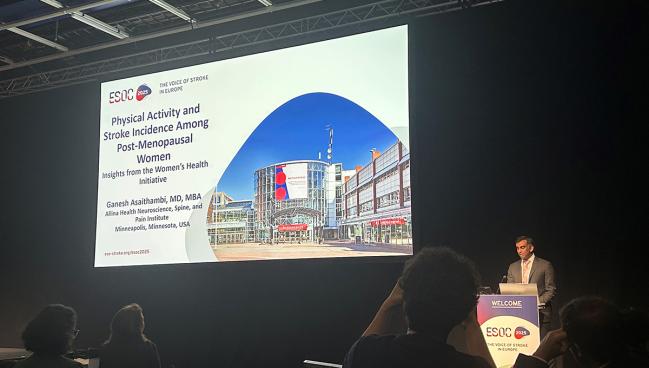Even Small Amounts of Exercise May Help Older Women Avoid Stroke
The findings from the Women’s Health Initiative are in line with recent guidelines for the primary prevention of stroke.

HELSINKI, Finland—The more recreational activity postmenopausal women can do at any level, the lower their likelihood of stroke, data from the Women’s Health Initiative indicate.
Each standard deviation (SD) increase in total activity was associated with a 10% lower relative risk of stroke over several years of follow-up. Women who performed the most moderate-intensity activity had a 25% reduced risk compared with their inactive peers, Ganesh Asaithambi, MD (Allina Health Neuroscience, Spine, and Pain Institute, Minneapolis, MN), reported here at the European Stroke Organisation Conference (ESOC) 2025.
Women who reported walking as their only exercise still saw a 6% lower risk of stroke for every SD increase in total activity, “emphasizing that purposeful movement at any comfortable pace matters,” he said.
These observational findings cannot be used to draw any conclusions about causality, and Asaithambi said more definitive answers about the impact of various activity levels in older women will be coming from the randomized Women’s Health Initiative Strong and Healthy (WHISH) trial, which has been completed but has not yet reported results.
“Meanwhile,” he said, “we have sufficient evidence to act. Let us embed physical activity counseling into every relevant encounter.”
Cheryl Bushnell, MD (Wake Forest University School of Medicine, Winston-Salem, NC), a moderator of the session where Asaithambi presented the results, said the study “reinforces what we already know about physical activity—that any kind of activity is useful in terms of reducing stroke risk.” She added that reducing sedentary behavior is particularly important.
Bushnell, chair of the 2024 guideline for the primary prevention of stroke from the American Heart Association/American Stroke Association, said these new findings are consistent with their recommendations around exercise. The data also show that the positive impact of physical activity on brain health isn’t just limited to those who are young or middle-aged. “You can be older and still get a benefit,” she stressed.
Cumulative Gains Over Time
Asaithambi and colleagues analyzed Women’s Health Initiative data on 139,871 postmenopausal women who were free from stroke at baseline in 1993 to 1998 and who completed questionnaires on how much they walked and performed other types of activities. Light activities included tasks performed around the house, whereas moderate activity included brisk walks and vigorous exercise included running or swimming. Energy expenditure was assessed using metabolic equivalent of task (MET) values.
Through a mean follow-up of 8.5 years, there were 4,642 strokes, mostly ischemic, recorded. A higher number of MET hours per week was associated with a lower risk of total stroke after accounting for demographic, lifestyle, and clinical factors (P < 0.001).
A 1-SD increase in total activity was equal to roughly 1.2 additional MET hours per week, and this was associated with a lower total stroke risk during follow-up (HR 0.90; 95% CI 0.87-0.93).
Looking at stroke subtypes according to imaging and TOAST criteria, the relationship with exercise appeared to be strongest for ischemic stroke—risk was lower by a relative 23% for women with the highest total activity level compared with those who were inactive. There was, however, a J-shaped association between ischemic stroke and vigorous activity specifically, suggesting that very intense exercise may not add extra protection for this subtype, Asaithambi said.
Exercise appeared to have the greatest impact on risk of large-vessel infarcts, with a hazard ratio of 0.81 (95% CI 0.70-0.95) for every 1-SD increase in total physical activity. Risk of cardioembolic events was lower with increased moderate-intensity exercise (HR 0.91; 95% CI 0.85-0.99), whereas small-vessel stroke risk was not associated with any level of activity.
The risk of hemorrhagic stroke was most strongly related to total and vigorous activity, with no clear associations with light and moderate activity.
Let us embed physical activity counseling into every relevant encounter. Ganesh Asaithambi
Asaithambi noted that the association between exercise and lower stroke risk was consistent across various subgroups, including those defined by age, body mass index, and the presence of hypertension. In addition, he reported, “when we updated activity over time, the advantage actually strengthened, pointing to cumulative gain.”
Sensitivity analyses removing various sources of potential bias provided similar overall results, which makes “a compelling argument for a genuine biological relationship rather than a statistical artifact,” Asaithambi said. Use of hormone replacement therapy, he noted, didn’t moderate the observed relationships.
“For clinicians, the takeaway is straightforward: encourage postmenopausal patients to embrace regular moderate motion. Think 30 minutes of brisk walking most days. Our data suggests that this modest habit could translate into nearly one-third fewer strokes. Such prescriptions are inexpensive, culturally adaptable, and already endorsed . . . by national guidelines,” he said. “Embedding them into routine care represents an immediate evidence-based pathway to lighten stroke burden.”
Asaithambi acknowledged that the study was limited by its observational design, which is open to residual confounding; the possibility of recall bias and misclassification when using self-reported activity data; and the lack of statistical power for the subtype analyses. In addition, there should be caution in extending the results to younger cohorts or to men, he said.
Both he and Bushnell said, however, that a similar protective effect of exercise would likely be seen in men. “There have been studies showing that,” Bushnell said.
Todd Neale is the Associate News Editor for TCTMD and a Senior Medical Journalist. He got his start in journalism at …
Read Full BioSources
Asaithambi G. Physical activity and stroke incidence among postmenopausal women: insights from the Women’s Health Initiative. Presented at: ESOC 2025. May 21, 2025. Helsinki, Finland.
Disclosures
- Asaithambi reports no relevant conflicts of interest.





Comments